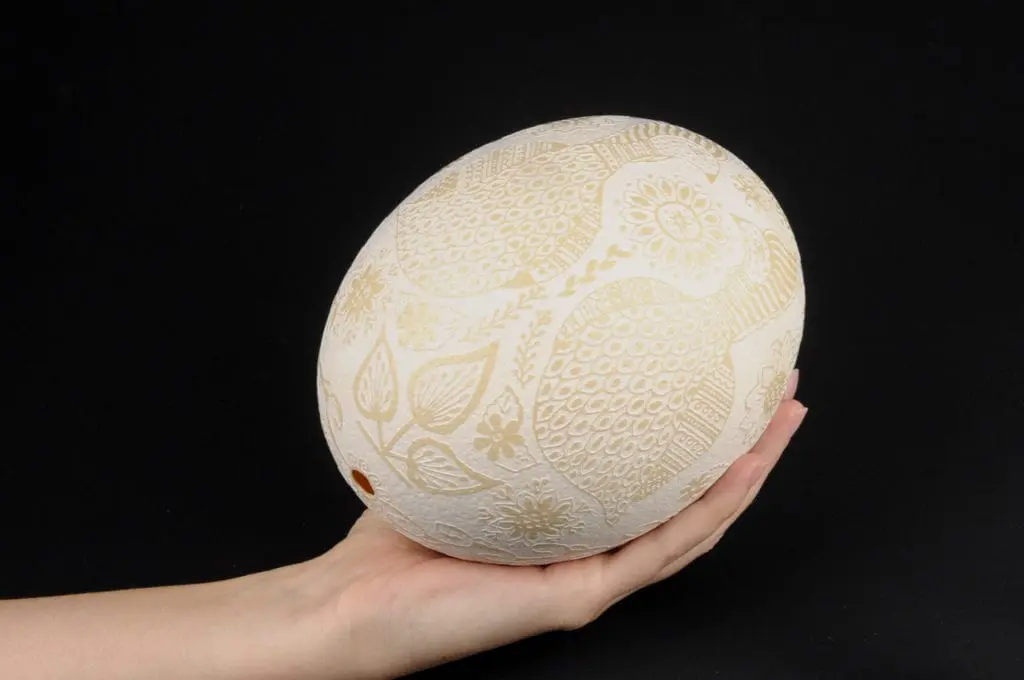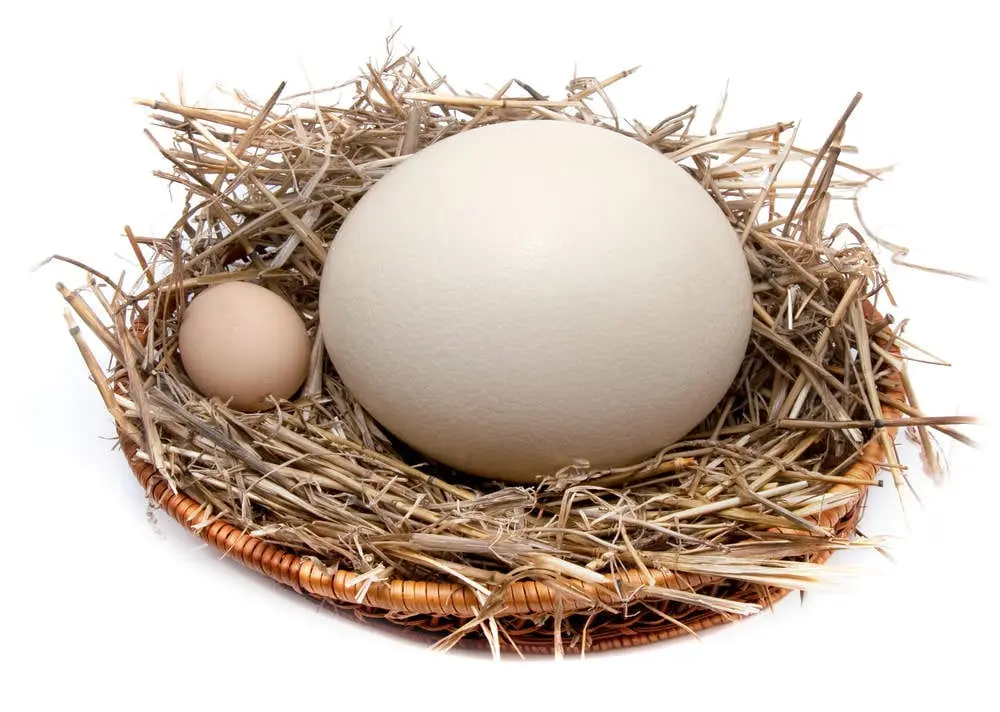Contents
Description of Ostrich eggs
The African ostrich is the largest bird on our planet, which lays the largest eggs. Imagine: a bird itself is more than 2 meters tall and weighs about 120 kg, and these eggs are 25 – 40 times larger than a chicken egg and can show a weight of up to 2.2 kg on the scales!
Females lay eggs only during the warmer months, from April to October. They do it every other day, bringing in up to 8 dozen per season. A healthy female lays eggs for 25 to 35 seasons.
Size is not the only significant difference between an ostrich and chicken egg. It is a nutritious dietary product with reduced fat and cholesterol content compared to chicken eggs. This food is rich in sodium and selenium, vitamins A and E, and exceeds chicken in the content of valuable amino acids. Calorie content – 118 kcal per 100 g.
The yolk ratio, which has a rich color, and the translucent protein by weight is about 1 to 3. The benefits of ostrich eggs are hard to overestimate!
The largest ostrich egg was obtained in China, its weight was over 2.3 kg, and its diameter was over 18 cm!

The ostrich egg has a solid shell that can withstand a load of about 50 kg. It resembles marble in appearance, so engraving and painting masters use it in artistic creation.
Food geography
The ostrich egg long ago and rather far “stepped” beyond the continent where these representatives of the avian world live. And if you could find earlier the egg itself and dishes from it only in Africa or the Middle East, today farmers bread ostriches in more than 50 countries of the world, including in countries with a cold climate, for example, Sweden.
However, the ostrich egg is still an overseas delicacy. Perhaps this is because you cannot find him in the market, in a store, or on a supermarket shelf. And everyone who wants to try it or replenish the menu of their restaurant has to order ostrich eggs on the farms engaged in breeding this bird.
Interesting Facts
An ostrich egg weighs from 1.5 to 2 kg (this is about 25-36 chicken eggs), while the protein in the egg is about 1 kg, and the yolk is 350 g. The ostrich egg is the largest in the world, and its diameter reaches 15-20 cm.
The shell of ostrich eggs is very thick. When broken, it looks like shards of crockery. In addition to culinary use, eggs are prevalent for decorative purposes. The empty shell is very durable and looks like porcelain. You may paint it, make miniature vases, boxes, and other souvenirs.

Ostrich eggshells have been inlaid with precious metals since the Middle Ages, when they were all used as ceremonial and extravagant glasses.
Copts, who still regard these eggs as a symbol of vigilance, hang eggs of Ostrich as religious items in their churches.
Composition and calorie content of Ostrich eggs
Calorie content
100 grams of the product contain 118 kcal.
Composition
Ostrich eggs contain small amounts of cholesterol and fat. Therefore they are dietary products. They contain many protein, calcium, potassium, phosphorus, vitamins A, E, carotenoids, essential amino acids.
- Proteins 55.11%
- Fat 41.73%
- Carbohydrates 3.16%
- 143 kcal
Storage
Thanks to their dense shell, it is possible to store these eggs for up to three months. Once cooked, you can store them in the refrigerator for two to three days.
The benefits of ostrich eggs
These eggs’ benefits are due to the rich composition of vitamins, minerals, amino acids, and other substances. This food contains less cholesterol than chicken eggs, which can be attributed to dietary products. These eggs contain polyunsaturated fatty acids, which are excellent prevention of heart and vascular problems.

This food contains vitamin A, which is essential for vision, and vitamin E, which is considered the best for the skin’s health and beauty. There are essential acids in this egg, which are actively involved in the building of muscle tissue.
Harm
Only in case of individual intolerance to the components of the food.
Taste qualities of ostrich eggs
They taste like chicken eggs but with a richer flavor. Due to their large size, these eggs are often used to prepare a large number of dishes. But, you can use the product in portions. Like a chicken egg, an unused ostrich egg can be stored in the refrigerator for several days. An unbroken egg has a longer shelf life – up to 3 months.
Cooking applications
Since an ostrich egg is not much different from a chicken egg, its cooking uses are the same. The only difference is in the time of cooking it entirely. This process will take at least 1 hour for hard-boiled and about 45 minutes for soft-boiled. But to cook classic scrambled eggs from it is not worth it because the duration of cooking caused by the size turns the finished dish into a tough and dried at the edges “sole.”

What to cook from ostrich egg:
- Omelettes with ham, vegetables, herbs, mushrooms and without.
- Omelet rolls with any filling.
- Salads that you can put eggs in.
- A pizza based on a baked egg.
- As a decoration element for a large portion of a dish.
- Bakery products.
The latter, baking, adding an ostrich egg instead of the usual chicken egg, makes the finished dish fragrant, piquant and unforgettable.
An ostrich egg is perfect for preparing large portions for 5-10 people or festive dishes, which involves many guests.
You can store an ostrich egg raw for up to 3 months by keeping it in the refrigerator. When ready, it is better to be stored boiled, cut into pieces every day, and go into use.
Today, the donation of ostrich eggs is gaining popularity. After all, this is an expensive and exotic gift and very nutritious food that can provide a family with a full breakfast or dinner.









